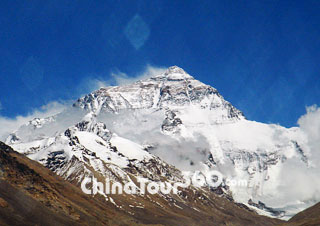 Mt. Everest
Mt. Everest
Among all mountain peaks of Himalayas, the pyramid-shaped, mighty and majestic one is the Everest with a height of 29,017 feet (8,844 meters) above sea level. This altitude is also the highest point on the earth. Blue sky, white snow and green mountains compose a most pure picture. The local Tibetans admire the Everest as the sacred Parvati. Everest's beauty is fascinating, because it is the venue nearest to the sky on the earth.
The Everest stands on the highest and biggest plateau in the world - the Qinghai-Tibet Plateau on China's southwestern border. Its southern slope is in Nepal, while the northern is in Tibet of China. The Everest was formed due to the collision between the Indian continental plate and the Asian continental plate. With the great pressure, a magnificent mountain was sprung up and the main peak of this mountain range is Mount Everest. Within 4,942 acres of the Everest, peaks over peaks made marvelous mountain splendor. More than 40 peaks are higher than 22,966 feet (7,000 meters) above the sea level, shaping an array of snow-capped mountains.
It is at clear dawn that Everest shows its most charming scenery. When the sun rises, while snow-capped mountains surrounding are still clad in darkness, Everest, because of its height, is to greet the first wisp of sunlight. White snow and black rocks are all dyed golden yellow, so the whole golden peak, standing in the vast snow-covered field, looks like the gods in arrange. The Mt Everest is named Zhumu Langma in Chinese: Zhumu in Chinese mean 'goddess' and langma mean 'the third' in Tibetan, since there are other four peaks here and Everest is the third one.
It is not easy to climb up the Everest and appreciate the scene. Everest Base Camp, where climbers usually start their journey, is located in Dingri County. It is more than 19,685 feet (6,000 meters) high and weather is really harsh. Because the altitude is too high, oxygen contained in the air is less than half of what is contained upon the offing. In summer, hurricanes may occur. The snowflakes rolled up by strong wind cover the earth and blacken the sky suddenly. This only happens in the area of South Pole and North Pole, so the Everest is also called 'the Third Pole of the Earth'.
However, the Everest is so attractive that the harsh natural condition cannot erase people's will to come closer to it. As the world's first summit, it has become all climbers' holy palace. From 18th century, some climbers came to detect its mysteries in succession. From the 1920s to the 1930s, British explorers tried to reach the peak from the northern slope for seven times, but they did not succeed. Some members even never came back.
In May of 1953, a Zelanian climber Edmund Hillary and a Nepali Tenzing Norgay finally achieved to stamp their footprints on the highest peak in the world. They overcame various difficulties and managed to reach the peak from the southern slope. In 1960, a Chinese mountaineering team succeeded in climbing up the Everest from the northern slope and inaugurated the northern route to the peak.
![]() Entranec Fee: CNY 180
Entranec Fee: CNY 180
![]() Best Time to Visit: Early Mar. to End of May & Early Sep. to End of Oct.
Best Time to Visit: Early Mar. to End of May & Early Sep. to End of Oct.
![]() Transportation: Tourists from China usually take a bus from Lhasa to Xegar via Gyantse and Shigatse along the Sino-Nepalese Highway, and then go southwards along the rough road of Pa Zhuo District.
Transportation: Tourists from China usually take a bus from Lhasa to Xegar via Gyantse and Shigatse along the Sino-Nepalese Highway, and then go southwards along the rough road of Pa Zhuo District.
![]() Location: The Everest stands on the highest and biggest plateau in the world - the Qinghai-Tibet Plateau on China's southwestern border, about 62 miles south of the Sino-Nepalese Highway.
Location: The Everest stands on the highest and biggest plateau in the world - the Qinghai-Tibet Plateau on China's southwestern border, about 62 miles south of the Sino-Nepalese Highway.
![]() Other Famous Shigatse Attraction: Rongbu Glacier
Other Famous Shigatse Attraction: Rongbu Glacier







